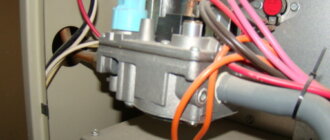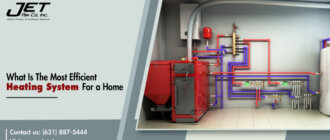Understanding a Commercial Hydronic Heating System
Are you tired of dealing with cold and drafty commercial spaces during the winter months? Look no further than a commercial hydronic heating system! This innovative heating solution utilizes water to evenly distribute warmth throughout your building, providing comfort and efficiency all season long. But what exactly is a hydronic heating system? In this blog post, we’ll take a deep dive into its components, how it works, and the benefits it can bring to your business. Get ready to warm up to the idea of commercial hydronic heating!
What is Hydronic Heating?
Hydronic heating is a type of heating system that uses hot water or steam to distribute heat throughout a building. Unlike traditional forced-air systems, which blow hot air through ducts, hydronic systems use radiators, baseboard heaters, or radiant floor heating panels to transfer heat into the space.
One key advantage of hydronic heating is its energy efficiency. Because water can hold more heat than air, it requires less energy to maintain a comfortable temperature in a room. Additionally, because the system operates at low pressure and temperature levels, there are fewer energy losses due to leaks and other inefficiencies.
There are different types of hydronic systems available for commercial buildings depending on their size and requirements. Some common configurations include boilers with multiple zones for better control over individual areas of the building as well as those that integrate renewable technologies such as solar thermal collectors.
In summary, hydronic heating provides an efficient way to keep commercial buildings warm without sacrificing comfort or wasting energy. By using hot water instead of air to distribute heat throughout your space, you can save money on your utility bills while also reducing your carbon footprint!
Types of Hydronic Heating Systems
When it comes to hydronic heating systems, there are a few different types that you should be aware of. The most common types include:
- Radiant Floor Heating System: In this type of system, the heat is generated by hot water flowing through pipes installed in the floor. As the heat radiates from the floor, it warms up everything in the room.
- Radiator Heating System: This type of system uses radiators or heating panels to distribute heat throughout a space. Hot water flows through these units and heats up the surrounding air.
- Baseboard Heating System: Similar to radiator systems, baseboard heating circulates hot water through metal pipes located along baseboards or walls.
- Fan Coil Units: These units use fans to move air across coils that contain hot water or steam, which helps distribute warmth evenly throughout a space.
Each type has its pros and cons depending on your specific needs and budgetary constraints. It’s important to work with an experienced professional when selecting and installing a hydronic heating system for maximum efficiency and safety.
Components of a Commercial Hydronic Heating System
A commercial hydronic heating system consists of several essential components that work together to provide consistent and reliable heat throughout a building. The main components include the boiler, piping, radiators/heating panels, expansion tank, pumps, and control system.
Boiler
The boiler is the heart of a commercial hydronic heating system. It is responsible for heating the water that will be circulated through the piping, radiators/heating panels, and eventually back to the boiler.
There are two main types of boilers used in hydronic heating systems: condensing and non-condensing. Condensing boilers have a higher efficiency rating as they recover heat from exhaust gases, while non-condensing boilers vent these gases directly outside.
Boilers can also run on different fuels such as natural gas, propane, or oil. Choosing the right fuel type depends on various factors such as availability and cost.
Proper sizing of the boiler is crucial to ensure it can meet the building’s heating demand without wasting energy. Oversized boilers not only waste energy but can also lead to temperature fluctuations in the building.
Regular maintenance and servicing of the boiler are necessary to maintain its performance and prevent breakdowns. This includes checking for leaks, ensuring proper combustion, cleaning burner assemblies, and replacing worn-out parts if needed.
Choosing an appropriate boiler size with regular maintenance will ensure optimal performance of a commercial hydronic heating system.
Piping
Piping is an essential component of a commercial hydronic heating system. It serves as the conduit for hot water to flow throughout the system, delivering heat to different areas of the building.
The type and size of piping used in a commercial hydronic heating system depend on several factors such as the size of the building, heat load requirements, and layout. Typically, copper or PEX pipes are used due to their durability and resistance to corrosion.
One important consideration when it comes to piping is insulation. Proper insulation can significantly reduce heat loss during transportation through pipes, which ultimately leads to more efficient operation and lower energy bills.
It’s also crucial that proper installation techniques are followed when installing piping. Poor workmanship or incorrect sizing can cause pressure drops leading to inefficient operation or even failure of the entire system.
Proper selection, installation, and maintenance of piping in a commercial hydronic heating system play an integral role in its overall performance and efficiency.
Radiators/Heating Panels
Radiators and heating panels are key components of a commercial hydronic heating system. These devices work by emitting heat into the surrounding air, providing warmth to indoor spaces.
Radiators come in various shapes and sizes, from sleek and modern designs to more traditional styles that fit with classic architecture. They can be mounted on walls or placed on the floor, depending on the needs of your building.
Heating panels, sometimes called radiant panels or radiant ceiling panels, are an alternative to traditional radiators that use electricity rather than hot water to produce heat. They can be installed directly into ceilings or walls for a sleeker look.
Both radiators and heating panels offer advantages over other types of heating systems such as forced-air systems. They provide consistent heat without creating drafts or hot spots in your space while also being quieter than other types of heaters.
Choosing between radiators and heating panels will depend on your specific needs and preferences. It’s important to consult with a professional installer who can help guide you through the selection process based on factors like building size and energy efficiency requirements.
Expansion Tank
An expansion tank is a crucial component of any commercial hydronic heating system. It’s responsible for regulating the pressure in the system, ensuring it doesn’t become too high or low.
The purpose of an expansion tank is to provide additional space for the water in the heating system to expand and contract without causing damage or leaks. This is especially important when temperatures fluctuate, as water naturally expands when heated.
Expansion tanks can be either diaphragm-type or bladder-type. Both types work by separating air from the water in the system, creating a cushion that absorbs pressure changes and prevents excess pressure build-up.
Without an expansion tank, your commercial hydronic heating system could experience significant problems such as leaks, boiler shutdown due to high-pressure safety switches activating, or even bursting pipes which could result in costly repairs and downtime.
It’s vital that you have your expansion tank checked regularly by a trained professional during routine maintenance checks to ensure it’s working correctly. If you notice any signs of wear or damage on your expansion tank (e.g., corrosion), call a licensed technician immediately before it becomes a bigger issue.
Pumps
Pumps are an essential component of a commercial hydronic heating system. They play the important role of circulating water throughout the system, enabling heat to be distributed evenly.
There are two main types of pumps used in hydronic heating systems: circulator pumps and zone valves. Circulator pumps are typically used in larger, more complex systems where multiple zones require independent temperature control. Zone valves, on the other hand, are used in smaller systems with only one or two heating zones.
When selecting a pump for your commercial hydronic heating system, it is important to consider factors such as flow rate and head loss. The right pump will ensure efficient operation and optimal performance.
Regular maintenance of your pump is crucial to ensuring its longevity and preventing costly breakdowns. This includes regular cleaning, lubrication, and replacing worn parts as needed.
Understanding the role that pumps play in your commercial hydronic heating system can help you make informed decisions about installation and maintenance to keep your building warm and comfortable all winter long.
Control System
The control system is a crucial component of any commercial hydronic heating system. It ensures that the system operates efficiently and maintains a comfortable indoor temperature.
The control system consists of various parts, including thermostats, sensors, and controllers. The thermostats are responsible for monitoring the temperature in each zone of the building and sending signals to the controller when adjustments need to be made.
The sensors measure outdoor temperatures and adjust the heating accordingly. They also monitor water temperatures within the pipes to ensure that they do not exceed safe levels.
Controllers manage all aspects of the heating system by receiving signals from thermostats or sensors and adjusting boiler output or pump speeds accordingly. This allows for precise temperature control throughout different zones of your building while saving energy costs.
Having a reliable control system can help you save on energy bills while providing optimal comfort levels throughout your commercial space. Regular maintenance checks should be performed on this important aspect of your hydronic heating systems to avoid any potential issues with its functioning in future years.
How Does a Commercial Hydronic Heating System Work?
A commercial hydronic heating system works by circulating heated water through a closed loop of pipes in the building. The water is heated in a boiler and then pumped through the piping to radiators or heating panels located in each room. Once the hot water reaches these units, it releases heat into the air, which warms up the space.
The system operates using natural convection or forced circulation. In natural convection, cooler air from below enters behind the radiator and displaces warm air that rises from above, creating a continuous cycle of warm air rising and cool air falling.
Forced circulation uses pumps to push hot water through the piping more quickly than natural convection would allow. This method allows for greater control over temperature regulation throughout different rooms in a building.
To maintain proper pressure within the system as temperatures change, an expansion tank is used to absorb excess pressure created by thermal expansion of hot water.
Commercial hydronic heating systems are efficient and reliable ways to provide consistent warmth throughout large buildings while also offering flexibility for temperature regulation in individual spaces.
Benefits of a Commercial Hydronic Heating System
A commercial hydronic heating system offers several benefits that make it a popular choice for many businesses. One of the key advantages is its energy efficiency, as hydronic systems use water to transfer heat instead of air. This means less energy is required to maintain a comfortable temperature, resulting in reduced operating costs.
Another benefit of hydronic heating systems is their versatility and flexibility. They can be installed in various building types and sizes, accommodating different heating needs and preferences. With zoning capabilities, each area or room can have individual temperature control providing comfort throughout the entire property.
In addition, hydronic heating systems operate quietly compared to forced-air systems since they do not require noisy blowers or fans. This makes them ideal for buildings such as hospitals or schools where noise levels must be kept low.
Hydronic heaters also provide better indoor air quality than other heating methods because there are no ducts circulating dust particles within your space.
With little maintenance needed beyond annual check-ups, these high-quality HVAC units will offer consistent performance over time without any major breakdowns, saving you even more money on repairs!
A commercial hydronic heating system provides numerous benefits including increased energy efficiency, flexibility in design options & installation locations along with quieter operation enhancing your indoor environment’s overall health & well-being!
Maintenance and Servicing of a Commercial Hydronic Heating System
Maintenance and servicing of a commercial hydronic heating system are crucial to ensure its longevity and efficiency. It’s important to have the system inspected regularly by a qualified technician who can identify any potential issues before they become major problems.
One important aspect of maintenance is checking the water levels in the expansion tank. Low water levels can cause damage to the boiler, so it’s important to make sure that they are at the correct level.
Another important part of maintenance is flushing out the system periodically. Over time, sediment can build up in the pipes and radiators, which reduces their efficiency. Flushing helps remove this sediment and allows for better heat transfer throughout the system.
It’s also essential to check all valves, pumps, and thermostats regularly as they play an integral role in regulating temperature throughout your building.
Having a regular servicing schedule will help keep your commercial hydronic heating system functioning optimally year-round. A professional service will include cleaning components such as burners or boilers, which may be clogged with debris over time.
Proper maintenance ensures both optimal performance from your commercial hydronic heating equipment while reducing energy costs over time.
Conclusion: The Value of Commercial Hydronic Heating Systems
In summary, a commercial hydronic heating system is an efficient and effective way to heat large buildings while maintaining comfortable temperatures. From the boiler to the radiators/heating panels, each component works together seamlessly to provide warmth throughout the space.
The benefits of a commercial hydronic heating system are numerous, including energy efficiency, cost savings over time, and improved indoor air quality. Additionally, these systems require minimal maintenance when installed properly.
Investing in a commercial hydronic heating system can be a wise decision for businesses looking to save money on their energy bills while also improving their building’s comfort level. With proper installation and regular maintenance from professionals, these systems can last for many years without needing significant repairs.
It’s clear that commercial hydronic heating systems offer great value for businesses seeking reliable and efficient temperature control solutions.



